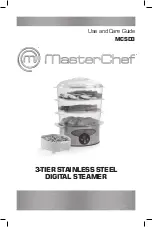
5168273-YIM-A-1115
Johnson Controls Unitary Products
37
Once the low-pressure switch has been proven (closed during
the 30-second monitor period described above), the UCB will
monitor the low-pressure limit switch for any openings. If the
low-pressure switch opens for greater than 5 seconds, the UCB
will de-energize the associated compressor, initiate the ASCD,
and, if the other compressor is idle, stop the condenser fans.
If the call for cooling is still present at the conclusion of the
ASCD, the UCB will re-energize the halted compressor.
Should a low-pressure switch open three times within one hour
of operation, the UCB will lock-out the associated compressor.
If the other compressor is inactive, the condenser fans will be
de-energized.
Evaporator Low Limit
During cooling operation, if the
Evaporator Low Limit Sensor
(EC1, 2)
(Located on the Suction Line at the Evaporator Coil.)
detects a temperature below 26 Deg. F (default), the UCB will
de-energize the associated compressor, initiate the ASCD, and,
if the other compressor is idle, stop the condenser fans. If the
call for cooling is still present at the conclusion of the ASCD, the
UCB will re-energize the halted compressor. Should the UCB
detect the evaporator low limit sensor
(EC1, 2)
falling below 26
Deg. F (default) three times within two hours of operation, the
UCB will lock-out the associated compressor. If the other
compressor is inactive, the condenser fans will be de-
energized.
Low Ambient Cooling
To determine when to operate in low ambient mode, the UCB
has an
Outdoor Air Temperature Sensor (OAT)
with a low
ambient setpoint at 45ºF (default). When the
OAT Sensor
senses a temperature below the low ambient setpoint and the
thermostat is calling for cooling, the UCB will operate in the low
ambient mode.
Low ambient mode operates the compressors in this manner:
10 minutes on, 5 minutes off. The indoor blower is operated
throughout the cycle. The 5-minute off period is necessary to
defrost the indoor coil.
Low ambient mode always begins with compressor operation.
Compressor minimum run time may extend the minutes of
compressor operation. The off cycle will begin immediately
following the elapse of the minimum run time.
When operating in low ambient mode, an evaporator low limit
sensor
(EC1, 2)
temperature below 26ºF will de-energize the
associated compressor. If the call for cooling is still present at
the end of the ASCD and the and the evaporator temperature
sensor
(EC1, 2)
temperature is above 26°F, the unit will resume
operation.
Safety Controls
The unit control board monitors the following inputs for each
cooling system:
1.
An evaporator low limit sensor
(EC1, 2)
(Located on the
Suction Line at the Evaporator Coil.) to protect against low
evaporator temperatures due to a low airflow or a low
return air temperature, set at 26°F.
2.
A high-pressure switch to protect against excessive
discharge pressures due to a blocked condenser coil or a
condenser motor failure, (opens at 625 ± 25 psig and
resets 525 ± 25 psig).
3.
A low-pressure switch to protect against loss of refrigerant
charge, (opens at 23 ± 5 psig and resets at 38 ± 5 psig).
The refrigeration systems are independently monitored and
controlled. On any fault, only the associated system will be
affected by any safety/preventive action. The other refrigerant
system will continue in operation unless it is affected by the
fault as well.
The unit control board monitors the temperature limit switch of
electric heat units.
Compressor Protection
In addition to the external pressure switches, the compressors
also have inherent (internal) protection. If there is an abnormal
temperature rise in a compressor, the protector will open to shut
down the compressor. The UCB incorporates features to
minimize compressor wear and damage. An
Anti-Short Cycle
Delay (ASCD)
is utilized to prevent operation of a compressor
too soon after its previous run. Additionally, a minimum run time
is imposed any time a compressor is energized.
The ASCD is initiated on unit start-up and on any compressor
reset or lock-out.
Reset
Remove the call for cooling or heating, by raising or lowering
thermostat setting higher than the conditioned space
temperature.
Electric Heating Sequence Of Operations
With Electric Heat
When the thermostat calls for the first stage of heating, the low
voltage control circuit is completed between “R” and “W1”. This
24vac signal is passed through the UCB to the RW1 Relay.
Contacts RW1-1 open, assuring the reversing valve cannot be
energized, except during defrost. Contacts RW1-2 close. After
its five minute ASCD timer is satisfied, the UCB closes its
internal compressor relay contacts, sending a 24vac signal to
the MV terminal of the UCB. If its ASCD timer is satisfied the
UCB will energize compressor #1 contactor M1. After a two
second delay, it then energizes compressor #2 contactor M2.
Therefore, on a call for heat from W1, both sets of compressors
are always energized, unless one or the other is locked out by
the UCB. Also on the call for heat, the UCB energizes the M4
and M6 contactor which brings on the condenser fans.
If the compressors alone cannot satisfy the heating
requirements a second stage call from the thermostat
completes the circuit between “R” and “W2”. This 24vac signal
is passed through the UCB to the RW2 relay. Contacts RW2-1
close, completing the circuit to the electric heat section (if
















































